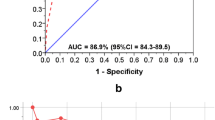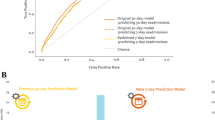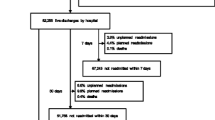Abstract
Potentially avoidable pediatric readmissions are a burden to patients and their families. Identifying patients with higher risk of readmission could help minimize hospital costs and facilitate the targeting of care interventions. HOSPITAL score is a tool developed and widely used to predict adult patient’s readmissions; however its predictive capacity for pediatric readmissions has not yet been evaluated. The aim of the study was to validate the HOSPITAL score application to predict 30-day potentially avoidable readmissions in a pediatric hospitalized population. This is a retrospective cohort study with patients under 18 years old admitted to a tertiary university hospital (n = 6,344). The HOSPITAL score was estimated for each admission. Subsequently, we classified the patients as low (0–4), intermediate (5–6), and high (7–12) risk groups. In order to estimate the discrimination power, the sensitivity, specificity, and accuracy were determined by the receiver operating characteristics (ROC) and the calibration by the Hosmer–Lemeshow goodness-of-fit. The 30-day hospital readmission was 11.70% (745). The accuracy was 0.80 (CI 95%, 0.77, 0.83), with a sensitivity of 70.96% and specificity of 78.29%, and a good calibration (p = 0.34).
Conclusion: HOSPITAL score showed a good discrimination and can be used to predict 30-day potentially avoidable readmission in a large pediatric population with different medical diagnoses. Our study validates and expands the usefulness of the HOSPITAL score as a tool to predict avoidable hospital readmissions for pediatric population.
What is Known: • Pediatric readmissions burden patients, the family network, and the health system. In addition, it influences negatively child development. • The HOSPITAL score is one of the tools developed and widely used to identify patients at high risk of hospital readmission, but its predictive capacity for pediatric readmissions has not been yet assessed. | |
What is New: • The HOSPITAL score showed good ability to identify a risk of 30-day potentially avoidable readmission in a pediatric population in different clinical contexts and diagnoses. • Our study expands the usefulness of the HOSPITAL score as a tool for predicting hospital readmissions for children and adolescents. |


Similar content being viewed by others
Data Availability
The data that support the findings of this study are available from the corresponding author, G.G.P, upon reasonable request.
Abbreviations
- AUC:
-
Area under the curve
- ICD:
-
International Statistical Classification of Diseases
- IQR:
-
Interquartile ranges
- ROC:
-
Receiver operating characteristic
- SD:
-
Standard deviation
References
Markham JL, Hall M, Gay JC et al (2018) Length of stay and cost of pediatric readmissions. Pediatrics 141:e20172934. https://doi.org/10.1542/peds.2017-2934
Feudtner C, Levin JE, Srivastava R et al (2009) How well can hospital readmission be predicted in a cohort of hospitalized children? A retrospective, multicenter study. Pediatrics 123:286–293. https://doi.org/10.1542/peds.2007-3395
Hartman ME, Saeed MJ, Bennett T et al (2017) Readmission and late mortality after critical illness in childhood*. Pediatr Crit Care Med 18:e112–e121. https://doi.org/10.1097/PCC.0000000000001062
Mumford V, Baysari MT, Kalinin D et al (2018) Measuring the financial and productivity burden of paediatric hospitalisation on the wider family network. J Paediatr Child Health 54:987–996. https://doi.org/10.1111/jpc.13923
da Silva VLS, de França GVA, Munhoz TN et al (2018) Hospitalization in the first years of life and development of psychiatric disorders at age 6 and 11: a birth cohort study in Brazil. Cad Saude Publica 34:1–13. https://doi.org/10.1590/0102-311x00064517
Coyne I (2006) Children’s experiences of hospitalization. J Child Heal Care 10:326–336. https://doi.org/10.1177/1367493506067884
Delvecchio E, Salcuni S, Lis A et al (2019) Hospitalized children: anxiety, coping strategies, and pretend play. Front Public Heal 7:1–8. https://doi.org/10.3389/fpubh.2019.00250
Cahayag V (2020) Hospitalization and child development: effects on sleep, developmental stages, and separation anxiety. Nurs Sr Theses 17. https://doi.org/10.33015/dominican.edu/2020.NURS.ST.09
Pufal EC, Müller AB, Bandeira PFR, Valentini NC (2018) Motor development in the hospitalized infant and its biological and environmental characteristics. Clin Biomed Res 38:66–73. https://doi.org/10.4322/2357-9730.75638
Han TS, Fluck D, Fry CH (2021) Validity of the LACE index for identifying frequent early readmissions after hospital discharge in children. Eur J Pediatr 180:1571–1579. https://doi.org/10.1007/s00431-021-03929-z
Ehwerhemuepha L, Finn S, Rothman M et al (2018) A novel model for enhanced prediction and understanding of unplanned 30-day pediatric readmission. Hosp Pediatr 8:578–587. https://doi.org/10.1542/hpeds.2017-0220
Donze J, Aujesky D, Williams D, Schnipper JL (2013) Potentially avoidable 30-day hospital readmissions in medical patients. JAMA Intern Med 173:632–638. https://doi.org/10.1001/jamainternmed.2013.3023
Donzé J, Williams MV, Robinson EJ et al (2017) International validity of the “HOSPITAL” score to predict 30-day potentially avoidable readmissions in medical patients. JAMA Intern Med 176:496–502. https://doi.org/10.1001/jamainternmed.2015.8462.International
Steyerberg EW, Vickers AJ, Cook NR et al (2010) Assessing the performance of prediction models. epidemiology 21:128–138. https://doi.org/10.1097/EDE.0b013e3181c30fb2
Swets JA (1988) Measuring the accuracy of diagnostic systems. Science (80-) 240:1285–1293. https://doi.org/10.1126/science.3287615
Rashikj Canevska O (2018) The impact of hospitalization on psychophysical development and everyday activities in children. Annu Fac Philos Skopje 71:465–470. https://doi.org/10.37510/godzbo1871465rc
Robinson R, Hudali T (2017) The HOSPITAL score and LACE index as predictors of 30 day readmission in a retrospective study at a university-affiliated community hospital. PeerJ 5:e3137. https://doi.org/10.7717/peerj.3137
Robinson R, Bhattarai M, Hudali T, Vogler C (2019) Predictors of 30-day hospital readmission: the direct comparison of number of discharge medications to the HOSPITAL score and LACE index. Futur Healthc J 6:209–214. https://doi.org/10.7861/fhj.2018-0039
Aubert C, Folly A, Mancinetti M et al (2016) Prospective validation and adaptation of the HOSPITAL score to predict high risk of unplanned readmission of medical patients. Swiss Med Wkly 146:w14335. https://doi.org/10.4414/smw.2016.14335
Burke RE, Schnipper JL, Williams MV et al (2017) The HOSPITAL score predicts potentially preventable 30-day readmissions in conditions targeted by the hospital readmissions reduction program. Med Care 55:285–290. https://doi.org/10.1097/MLR.0000000000000665
Su M-C, Wang Y-J, Chen T-J et al (2020) Assess the performance and cost-effectiveness of LACE and HOSPITAL re-admission prediction models as a risk management tool for home care patients: an evaluation study of a medical center affiliated home care unit in Taiwan. Int J Environ Res Public Health 17:927. https://doi.org/10.3390/ijerph17030927
Robinson R (2016) The HOSPITAL score as a predictor of 30 day readmission in a retrospective study at a university affiliated community hospital. PeerJ 4:e2441. https://doi.org/10.7717/peerj.2441
Zhou H, Della P, Roberts P et al (2019) A 5-year retrospective cohort study of unplanned readmissions in an Australian tertiary paediatric hospital. Aust Heal Rev 43:662–671. https://doi.org/10.1071/AH18123
Synhorst DC, Hall M, Harris M et al (2020) Hospital observation status and readmission rates Pediatrics 146. https://doi.org/10.1542/peds.2020-003954
Berry JG, Toomey SL, Zaslavsky AM et al (2013) Pediatric readmission prevalence and variability across hospitals. JAMA - J Am Med Assoc 309:372–380. https://doi.org/10.1001/jama.2012.188351
Taylor T, Altares Sarik D, Salyakina D (2020) Development and validation of a web-based pediatric readmission risk assessment tool. Hosp Pediatr 10:246–256. https://doi.org/10.1542/hpeds.2019-0241
Auger KA, Teufel RJ, Harris JM et al (2017) Children’s hospital characteristics and readmission metrics. Pediatrics 139:e20161720. https://doi.org/10.1542/peds.2016-1720
Jutras C, Charlier J, François T, Du Pont-Thibodeau G (2020) Anemia in pediatric critical care. Int J Clin Transfus Med 8:23–33
Melku M, Alene KA, Terefe B et al (2018) Anemia severity among children aged 6–59 months in Gondar town, Ethiopia: a community-based cross-sectional study. Ital J Pediatr 44:1–12. https://doi.org/10.1186/s13052-018-0547-0
Walter T, De Andraca I, Chadud P, Perales CG (1989) Iron deficiency anemia: adverse effects on infant psychomotor development. Pediatrics 84:7–17
Akirov A, Diker-Cohen T, Steinmetz T et al (2017) Sodium levels on admission are associated with mortality risk in hospitalized patients. Eur J Intern Med 46:25–29. https://doi.org/10.1016/j.ejim.2017.07.017
Hoenk K, Torno L, Feaster W et al (2021) Multicenter study of risk factors of unplanned 30-day readmissions in pediatric oncology. Cancer reports (Hoboken, NJ) 4:e1343. https://doi.org/10.1002/cnr2.1343
Acknowledgements
We thank the technology and information center (CTI) team of the Clinical Hospital of the Federal University of Uberlandia for helping in database extraction. N.C.S received a doctoral fellowship from the “Foundation for Research Support of the State of Minas Gerais” (FAPEMIG – Fundação de Amparo à Pesquisa do Estado de Minas Gerais). André R. Backes gratefully acknowledges the financial support of CNPq - Conselho Nacional de Desenvolvimento Científico e Tecnológico (Grant #307100/2021-9). Marcelo K. Albertini gratefully acknowledges the financial support of CNPq (Grant #406418/2021-7).
Funding
This study received financial support from “the Foundation for Research Support of the State of Minas Gerais” (FAPEMIG – Fundação de Amparo à Pesquisa do Estado de Minas Gerais) in a public call process number APQ-01331–21.The funder had no role in study design, data collection and analysis, decision to publish, or preparation of the manuscript.
Author information
Authors and Affiliations
Contributions
Silva conceptualized and investigated the study, designed the methodology, performed the formal analyses and data curation of the study, drafted the initial manuscript, and reviewed the manuscript. Albertini conceptualized and investigated the study, and reviewed the manuscript. Backes conceptualized and investigated the study, and reviewed the manuscript. Pena conceptualized and investigated the study, designed the methodology, and reviewed the manuscript. All authors approved the final manuscript as submitted and agree to be accountable for all aspects of the work.
Corresponding author
Ethics declarations
Ethics approval
The Research Ethics Committee of Federal University of Uberlandia approved this study (protocol number: 5.003.236).
Conflict of Interest
The authors declare no competing interests.
Additional information
Communicated by Peter de Winter.
Publisher's Note
Springer Nature remains neutral with regard to jurisdictional claims in published maps and institutional affiliations.
Rights and permissions
Springer Nature or its licensor (e.g. a society or other partner) holds exclusive rights to this article under a publishing agreement with the author(s) or other rightsholder(s); author self-archiving of the accepted manuscript version of this article is solely governed by the terms of such publishing agreement and applicable law.
About this article
Cite this article
da Silva, N.C., Albertini, M.K., Backes, A.R. et al. Validation of the HOSPITAL score as predictor of 30-day potentially avoidable readmissions in pediatric hospitalized population: retrospective cohort study. Eur J Pediatr 182, 1579–1585 (2023). https://doi.org/10.1007/s00431-022-04795-z
Received:
Revised:
Accepted:
Published:
Issue Date:
DOI: https://doi.org/10.1007/s00431-022-04795-z




